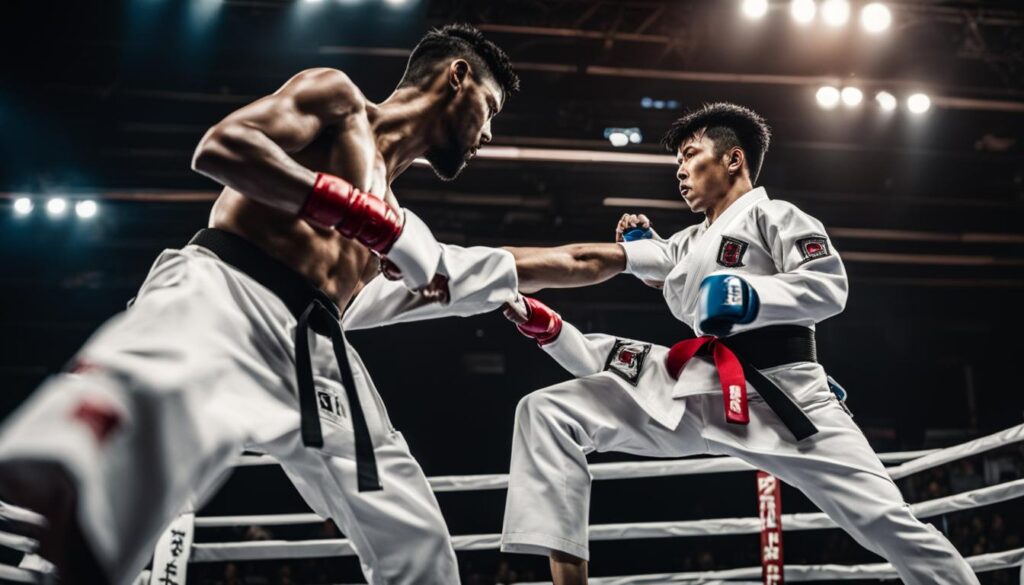When it comes to self-defense techniques, martial arts styles like karate and taekwondo are often considered the go-to options. But which one is better for self-defense? Let’s delve into the differences between karate and taekwondo to help you make an informed decision.
Key Takeaways:
- Karate and taekwondo are both effective martial arts styles for self-defense.
- Karate focuses more on hand combinations and punches, while taekwondo emphasizes kicking techniques.
- Karate originated in Japan and emphasizes mental strength, while taekwondo originated in Korea and emphasizes leg techniques.
- Both martial arts offer physical and mental benefits, such as improved fitness and discipline.
- The choice between karate and taekwondo for self-defense depends on personal preference and goals.
The Difference in Techniques
The main difference between karate and taekwondo lies in their emphasis on different techniques. Karate focuses more on hand combinations and punches, with kicking as a secondary aspect. Taekwondo, on the other hand, places a higher emphasis on kicking techniques and incorporates spinning and jumping kicks.
| Karate | Taekwondo |
|---|---|
| Emphasis on hand combinations and punches | Emphasis on kicking techniques |
| Kicking as a secondary aspect | Incorporates spinning and jumping kicks |
The choice between the two depends on your preference for using hands or legs as your primary form of self-defense.
Origins and Philosophy
Karate and Taekwondo, both self-defense martial arts, have unique origins and philosophical foundations that shape their practices. Understanding their roots can provide valuable insights into the essence of each martial art.
First developed in Japan approximately 500 years ago, Karate emerged as a means of self-defense without weapons. Its practitioners honed their mental strength and stamina to execute powerful strikes and blocks effectively. Karate places a greater emphasis on utilizing hand techniques, making it a versatile martial art for self-defense.
Taekwondo, on the other hand, traces its origins back to ancient Korea, with a history dating back to 50 B.C.E. Known as the “art of the foot and hand,” Taekwondo embraces the use of legs as weapons. The martial art highlights swift, high kicks and dynamic movements while incorporating hand strikes and blocks. Its philosophy aligns with discipline, respect, and personal growth, similar to that of Karate.
“The discipline and values ingrained in both Karate and Taekwondo go far beyond physical techniques, promoting a holistic approach to self-defense and personal development.”
Both Karate and Taekwondo embody a philosophical aspect that transcends physical techniques. They foster discipline, respect for oneself and others, and personal growth. These values are instilled in practitioners, shaping their character and mindset beyond the scope of self-defense.

Next, we will explore the competition rules governing Karate and Taekwondo and how they may influence your decision when considering these martial arts for self-defense training.
Competition and Rules
When considering karate vs taekwondo for self-defense, it’s important to understand the different competition rules associated with each martial art. Both karate and taekwondo have their own unique styles and regulations when it comes to competing.
In karate, there are two main types of competitions: light contact and full contact. In light contact competitions, the focus is on scoring points without causing harm to the opponent. Strikes are controlled and aim to demonstrate technique and skill rather than causing injury. Full contact competitions, on the other hand, allow for more intense strikes and knockouts. These competitions can be more physically demanding and require a higher level of conditioning and preparation.
In contrast, taekwondo competitions emphasize specific techniques and award points accordingly. Points are typically awarded for kicks to the head or spinning kicks to the torso, showcasing the athleticism and agility of the competitors. Taekwondo competitions often involve dynamic moves and impressive displays of flexibility.
When choosing between karate and taekwondo for self-defense, it’s important to consider the competition rules that align with your personal preference for competition style. If you prefer controlled strikes and a focus on overall technique, karate may be more suited to your taste. Alternatively, if you excel at kicks and flashy maneuvers, taekwondo might be the martial art of choice for you.
As you make your decision, take into consideration the different competition styles and what resonates most with your self-defense goals. Remember that self-defense training is not solely dependent on competition rules, but also encompasses various techniques, situational awareness, and mental preparedness.
Training and Benefits
Both karate and taekwondo provide effective self-defense training and offer numerous benefits. Engaging in these martial arts for self-defense requires mental and physical strength, discipline, and stamina. By training in either karate or taekwondo, individuals can improve their fitness levels, coordination, balance, and flexibility.
Moreover, both martial arts offer opportunities for personal growth, goal setting, and recognition through belt ranking systems. As practitioners progress through the ranks, they gain a sense of accomplishment and pride in their achievements, further motivating them to continue their training.
| Training and Benefits | Karate | Taekwondo |
|---|---|---|
| Improved Fitness | ✓ | ✓ |
| Enhanced Coordination | ✓ | ✓ |
| Improved Balance | ✓ | ✓ |
| Increased Flexibility | ✓ | ✓ |
| Personal Growth | ✓ | ✓ |
| Goal Setting | ✓ | ✓ |
| Belt Ranking System | ✓ | ✓ |
When deciding between karate and taekwondo for self-defense training, it is essential to align your choice with your personal preferences and specific goals. Whether you are drawn to the power of karate or the aerial kicks of taekwondo, both martial arts have proven to be effective forms of self-defense and provide a range of physical and mental benefits.
Remember, the choice between karate and taekwondo is a personal one, and it’s crucial to select the martial art that resonates with you the most.
Karate vs Taekwondo in MMA
While both karate and taekwondo have been adapted and used in mixed martial arts (MMA), karate has seen more success in the MMA world. Karate stylists, such as Lyoto Machida and Stephen Thompson, have utilized their karate skills to confuse opponents with fast kicks and different punch techniques. Taekwondo, being focused mainly on kicking, has less versatility in MMA but can still provide some unique techniques. The choice for MMA training should take into account the specific style and techniques that resonate with you.

Conclusion
In conclusion, when it comes to choosing between karate and taekwondo for self-defense, it all comes down to personal preference and individual goals. Both martial arts offer effective self-defense techniques and provide numerous physical and mental benefits.
Karate focuses on hand combinations and punches, while taekwondo places a higher emphasis on kicking techniques. Depending on your preference for using hands or legs as your primary form of self-defense, you can make an informed decision.
Both karate and taekwondo require discipline, dedication, and perseverance. They improve physical fitness, coordination, balance, and flexibility. Additionally, they promote personal growth through goal setting and recognition in their belt ranking systems.
The best martial art for self-defense is the one that resonates with you and motivates you to practice and master it. To make an informed decision, try out both styles and see which one suits you best. Begin your martial arts journey today by taking the first step towards self-defense and personal growth.
FAQ
Which martial art is better for self-defense, karate or taekwondo?
The choice between karate and taekwondo for self-defense ultimately depends on personal preferences, goals, and the specific techniques that resonate with you.
What is the main difference in techniques between karate and taekwondo?
Karate focuses more on hand combinations and punches, while taekwondo places a higher emphasis on kicking techniques.
What are the origins and philosophies of karate and taekwondo?
Karate originated in Japan around 500 years ago as a means of self-defense without weapons, while taekwondo has its roots in Korea and dates back to 50 B.C.E.
What are the competition rules for karate and taekwondo?
Karate has light contact and full contact competitions, while taekwondo competitions award points for specific techniques.
What are the training and benefits of practicing karate or taekwondo for self-defense?
Both martial arts require mental and physical strength, discipline, and stamina. They also improve fitness, coordination, balance, and flexibility, while promoting personal growth and goal setting.
How are karate and taekwondo utilized in MMA?
Karate stylists, such as Lyoto Machida and Stephen Thompson, have seen success in MMA with their fast kicks and unique punch techniques. Taekwondo, with its emphasis on kicking, can provide some unique techniques in MMA as well.
What is the best martial art for self-defense?
The best martial art for self-defense is the one that you take the initiative to practice and master. It ultimately depends on personal preference and the specific techniques that resonate with you.
